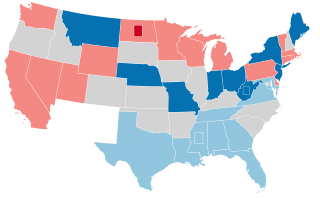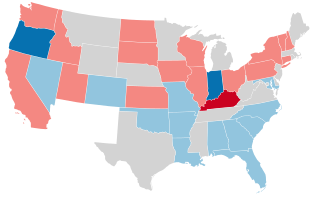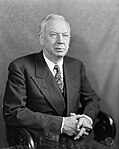
The 1980 United States Senate elections were held on November 4, coinciding with Ronald Reagan's victory in the presidential election. The 34 Senate seats of Class 3 were contested in regular elections. Reagan's large margin of victory over incumbent Jimmy Carter gave a huge boost to Republican Senate candidates, allowing them to flip 12 Democratic seats and win control of the chamber for the first time since the end of the 83rd Congress in January 1955.

The 1962 United States Senate elections was an election for the United States Senate. Held on November 6, the 34 seats of Class 3 were contested in regular elections. Special elections were also held to fill vacancies. They occurred in the middle of President John F. Kennedy's term. His Democratic Party made a net gain of four seats from the Republicans, increasing their control of the Senate to 68–32. However, this was reduced to 67–33 between the election and the next Congress, as on November 18, 1962, Democrat Dennis Chávez, who was not up for election that year, died. He was replaced on November 30, 1962, by Republican appointee Edwin L. Mechem. Additionally, Democrat Strom Thurmond became a Republican in 1964, further reducing Democrats to 66–34. This was the first time since 1932 that Democrats gained seats in this class of Senators.

The 1960 United States Senate elections coincided with the election of John F. Kennedy as president on November 8, 1960. The 33 seats of Class 2 were contested in regular elections. A special election was also held on June 28, 1960, for a mid-term vacancy in North Dakota where Democrats flipped a seat to expand their majority to 66–34. As Majority Leader Lyndon Johnson was elected Vice President, Mike Mansfield became the new majority leader.

The 1946 United States Senate elections were held November 5, 1946, in the middle of Democratic President Harry S. Truman's first term after Roosevelt's passing. The 32 seats of Class 1 were contested in regular elections, and four special elections were held to fill vacancies. The Republicans took control of the Senate by picking up twelve seats, mostly from the Democrats. This was the first time since 1932 that the Republicans had held the Senate, recovering from a low of 16 seats following the 1936 Senate elections.

Joseph Finch Guffey was an American business executive and Democratic Party politician from Pittsburgh, Pennsylvania. Elected from Pennsylvania to the United States Senate, he served two terms, from 1935 until 1947.

The 1910–11 United States Senate election were held on various dates in various states. As these U.S. Senate elections were prior to the ratification of the Seventeenth Amendment in 1913, senators were primarily chosen by state legislatures. Senators were elected over a wide range of time throughout 1910 and 1911, and a seat may have been filled months late or remained vacant due to legislative deadlock. However, some states had already begun direct elections during this time. Oregon pioneered direct election and experimented with different measures over several years until it succeeded in 1907. Soon after, Nebraska followed suit and laid the foundation for other states to adopt measures reflecting the people's will. By 1912, as many as 29 states elected senators either as nominees of their party's primary or in conjunction with a general election.

The 1908–09 United States Senate elections were held on various dates in various states. As these U.S. Senate elections were prior to the ratification of the Seventeenth Amendment in 1913, senators were primarily chosen by state legislatures. Senators were elected over a wide range of time throughout 1906 and 1907, and a seat may have been filled months late or remained vacant due to legislative deadlock. However, some states had already begun direct elections during this time. Oregon pioneered direct election and experimented with different measures over several years until it succeeded in 1907. Soon after, Nebraska followed suit and laid the foundation for other states to adopt measures reflecting the people's will. By 1912, as many as 29 states elected senators either as nominees of their party's primary or in conjunction with a general election.

The 1892–93 United States Senate elections were held on various dates in various states, coinciding with former Democratic President Grover Cleveland's return to power. As these U.S. Senate elections were prior to the ratification of the Seventeenth Amendment in 1913, senators were chosen by state legislatures. Senators were elected over a wide range of time throughout 1892 and 1893, and a seat may have been filled months late or remained vacant due to legislative deadlock. In these elections, terms were up for the senators in Class 1.

The 1980 United States Senate election in Pennsylvania was held on November 4, 1980. Incumbent Republican U.S. Senator Richard Schweiker decided to retire, instead of seeking a third term.

The 1944 United States Senate election in Pennsylvania was held on November 7, 1944. Incumbent Republican U.S. Senator James J. Davis sought re-election, but was defeated by Democratic nominee Francis J. Myers.

The 1958 United States Senate election in Pennsylvania was held on November 4, 1958. Incumbent Republican U.S. Senator Edward Martin did not seek re-election. The Republican nominee, Hugh Scott, defeated Democratic nominee George M. Leader for the vacant seat.

The 1968 United States Senate election in Pennsylvania was held on November 5, 1968. Incumbent Democratic U.S. Senator Joseph S. Clark Jr. sought re-election to a third term but was defeated by Republican U.S. Representative Richard Schweiker. This election marked the last time that an incumbent Senator lost re-election to this seat.

The 1952 United States Senate election in Pennsylvania was held on November 4, 1952. Incumbent Republican U.S. Senator Edward Martin successfully sought re-election to another term, defeating the Democratic nominee, Guy K. Bard.

The 1940 United States Senate election in Pennsylvania was held on November 5, 1940. Incumbent Democratic U.S. Senator Joseph F. Guffey successfully sought re-election to another term, defeating the Republican nominee, Jay Cooke.

The 1934 United States Senate election in Pennsylvania was held on November 6, 1934. Incumbent Republican U.S. Senator David A. Reed sought re-election to another term, but was defeated by Democratic nominee Joseph F. Guffey.

The 1946 United States Senate election in Minnesota took place on November 5, 1946. It was the first election to either of Minnesota's seats in the United States Senate held since the Minnesota Democratic Party and the Farmer-Labor Party of Minnesota merged in 1944, to form the Minnesota Democratic-Farmer-Labor Party. Incumbent U.S. Senator Henrik Shipstead was defeated in the Republican primary by Governor Edward John Thye, who went on to defeat DFL challenger Theodore Jorgenson in the general election.

The 1952 United States Senate election in Wisconsin was held on November 4, 1952.

The United States Senate election of 1928 in New Jersey was held on November 6, 1928. Incumbent Democratic Senator Edward I. Edwards ran for re-election to a second term in office, but was defeated by Hamilton Fish Kean in a landslide. This was the third of four straight elections to this seat in which the incumbents were defeated.

The 1946 United States Senate election in Tennessee was held on November 5, 1946. Incumbent Democratic Senator Kenneth D. McKellar was re-elected to a sixth term in office. He defeated a primary challenge by Edward W. Carmack Jr. and easily won the general election against Republican William B. Ladd, and Independent candidate John Randolph Neal Jr.
A Massachusetts general election was held on November 6, 1956, in the Commonwealth of Massachusetts.






















